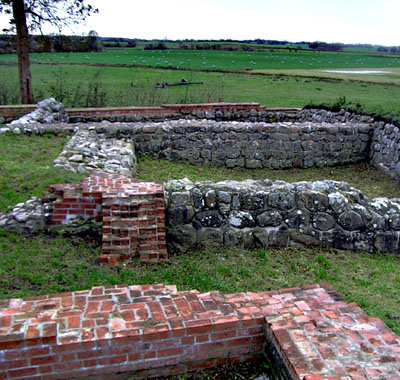| Biskop og kongekonflikt

| | I nutiden syner Søborg slotsruin i Nordsjælland ikke af meget i landskabet. Men midt i 1100-tallet var den et vigtigt holdepunkt for Sjællands biskop.
Ved uoverensstemmelserne med ærkebispen Eskild overtog kong Valdemar den Store, den solidt byggede borg i 1161. |
Strid og forsoning
I 1135 modtog domkirken i Lund et gavebrev, der skænkede den jordegods på Amager og i Skåne samt ”immunitet og fuldstændig frihed for al kongen tilkommende ret”. Sådanne formuleringer omkring forholdet imellem den kirkelige og verdslige magt er ikke uden problemer og vidnesbyrd om uenigheder imellem kirken og den styrkede kongemagt omkring midten af 1100-tallet findes i Roskildekrøniken, den første sammenhængende danmarkshistorie, der er forfattet omkring 1140, formodentlig på foranledning af ærkebiskop Eskild.
Ærkebiskop Eskild
Eskild var stormand af Trugotslægten, havde i sin ungdom studeret i Heidelberg og Paris, var internationalt orienteret og havde personlige kontakter til pavekirkens ledende skikkelser. Eskild var en fremragende organisator. Han sørgede for udbygning af domkapitlerne, grundlagde ærkebispesædets by Aahus i det nordøstlige Skåne på jord skænket af kongen i 1149 og arbejdede også ihærdigt for indførelse af frie bispevalg og klostergrundlæggelser.
Eskild var internationalt orienteret og rustet til at tage del i den politiske magtkamp imellem kirkemagt og kongemagt, pave og kejser, den såkaldte investiturstrid, som handlede om kirkens ret til at udpege sine egne ledere, og som kommer til at præge hans tidsalder. Ærkebiskop Eskild bliver selv anledning til en længerevarende strid imellem de to parter, da han tages til fange af kejserens mænd i Tyskland under en rejse til Rom. Fra dette fangenskab skriver Eskild hjem i et for tiden sjældent, personligt dokument.
Eskild slipper dog fri og vender hjem igen, men omkring 1159 rager han uklar med kong Valdemar den Store(1157-82), der har besteget tronen i 1157. Kong Valdemar har formelt set givet sig ind under den tysk-romerske kejser og derfor kommer kirke- og kongemagt i Danmark til at stå på hver sin side i investiturstriden. Måske som konsekvens heraf drager Eskild i 1161 i eksil og vender først tilbage igen i 1168.

Bisp Eskild | 
Aahus | 
Søborg Slot | 
Plan over ruinen | 
Søborg kirke |
|